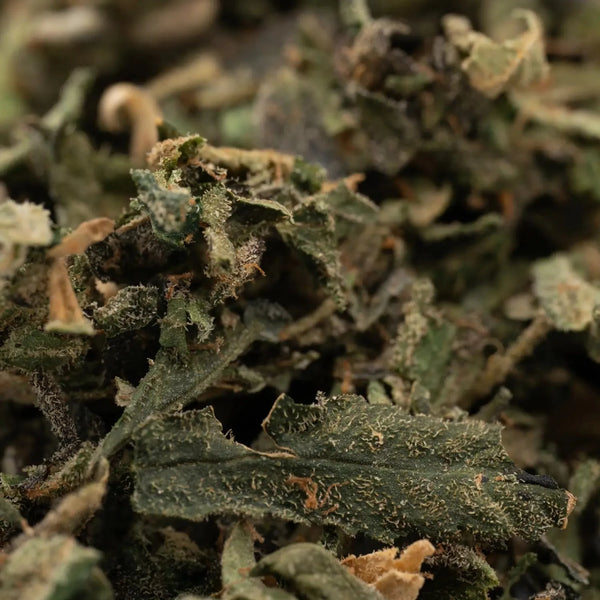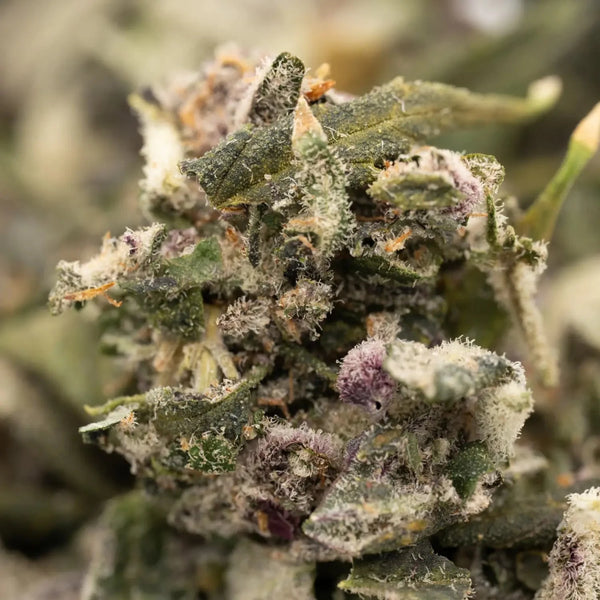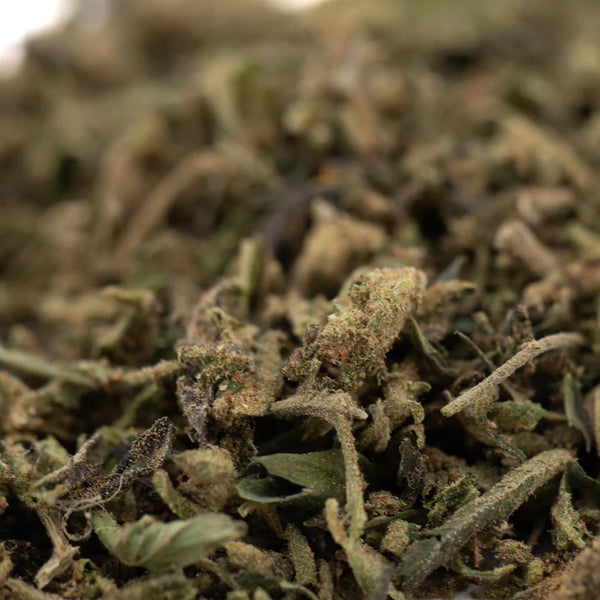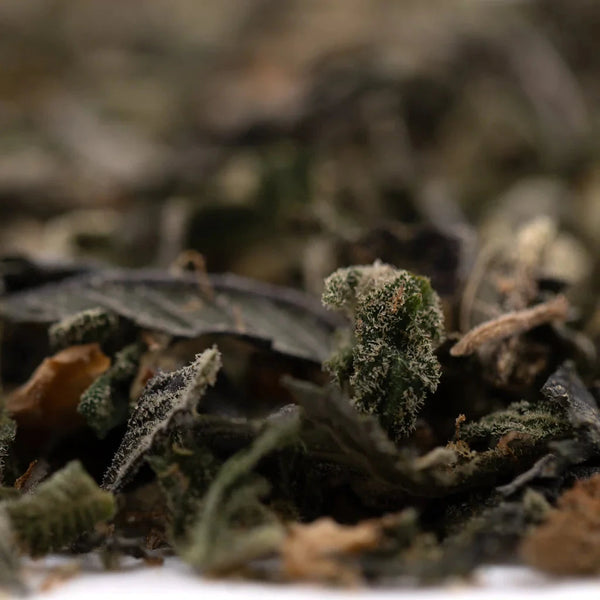No Products in the Cart
INDOOR THCA FLOWER 5g - $39.99 | GREENHOUSE THCA FLOWER 7g - $34.99

If you're exploring the world of THCA products, you've likely encountered a crucial decision point: should you buy premium flower buds or more affordable trim? This isn't just about saving money—understanding the difference between THCA trim and flower can significantly impact your experience, consumption methods, and overall satisfaction with your purchase.
The cannabis market has evolved dramatically, and THCA products now come in various forms and price points. While premium flower has traditionally been the gold standard, THCA trim has emerged as a compelling alternative that deserves serious consideration. But what exactly separates these two products, and more importantly, which one aligns with your specific needs and budget?
In this comprehensive guide, we'll break down everything you need to know about THCA trim vs flower. We'll examine the visual and physical differences, compare potency levels, analyze price points, explore ideal use cases, and help you make an informed decision. Whether you're a budget-conscious consumer, an extraction enthusiast, or someone seeking the premium flower experience, this comparison will equip you with the knowledge to choose wisely.
By the end of this article, you'll understand not just the surface-level differences, but the nuanced considerations that make each product valuable in different contexts. Let's dive into the world of THCA trim vs bud and discover which option deserves a place in your collection.
The most immediate and obvious distinction between trim and flower becomes apparent the moment you open your package. These visual and physical differences aren't just cosmetic—they tell a story about the product's origin, processing, and potential uses.
THCA Flower Appearance
Premium THCA flower consists of the dense, resinous buds that form at the plant's flowering sites. These buds are typically well-manicured, showcasing tight, compact structures covered in visible trichomes—the tiny, crystal-like glands that house cannabinoids and terpenes. When you examine quality flower, you'll notice distinct coloration ranging from deep greens to purples, complemented by vibrant orange or rust-colored pistils (the hair-like structures). The trichome coverage gives premium buds a frosted, almost glittery appearance that catches light beautifully.
The structure of flower buds is noticeably dense and substantial. When you handle them, they have weight and integrity, breaking apart with a satisfying texture that releases aromatic terpenes. The buds maintain their shape and don't crumble into dust—they separate into smaller nugs and individual calyxes. This structural integrity is a key indicator of THCA trim quality vs flower.
THCA Trim Appearance
THCA trim presents a markedly different visual profile. Trim consists of the sugar leaves, smaller foliage, and plant material that surrounds the main flower buds during growth and gets removed during the manicuring process. This material includes leaves that were close to the buds (often called "sugar trim" due to their trichome coverage), as well as smaller pieces of flower that broke off during handling.
When you examine trim, you'll find a mixture of sizes and shapes—from larger leaf sections to tiny bud fragments. The material is less uniform than flower, with more visible stems and leafy structure. However, quality trim still displays trichome coverage, particularly on sugar leaves that were closest to the buds. The color tends toward lighter greens and browns, with less visual density than whole flower buds.
The texture of trim is noticeably different in hand. It's lighter, more airy, and breaks apart more easily than dense flower. Some pieces may feel brittle or dry, while others retain some of the sticky resin that indicates cannabinoid presence. Understanding these THCA flower vs shake vs trim distinctions helps set appropriate expectations.
Handling and Storage Considerations
These physical differences extend to practical handling. Flower buds require careful storage to maintain their structure and trichome integrity—they can be damaged by excessive handling or compression. Trim, being already broken down, is more forgiving in storage but can dry out more quickly due to increased surface area. Both should be stored in airtight containers away from light and heat, but trim's smaller pieces make it more prone to further degradation if not properly maintained.

Understanding THCA trim potency versus flower potency requires examining where cannabinoids concentrate on the cannabis plant and how processing affects these concentrations.
Where Cannabinoids Live
THCA (tetrahydrocannabinolic acid) and other cannabinoids are produced in trichomes—microscopic glands that appear as crystal-like structures on cannabis plants. These trichomes are most densely concentrated on flower buds, particularly on the calyxes and bracts that form the bud structure. However, trichomes also appear on sugar leaves and even fan leaves to varying degrees, with density decreasing as you move away from the flower clusters.
This biological reality creates the fundamental potency difference between flower and trim. Premium flower buds can test anywhere from 20% to 30%+ THCA content, with some exceptional genetics reaching even higher percentages. The dense trichome coverage and optimal growing conditions contribute to these impressive numbers.
THCA Trim Strength and Testing
THCA trim strength typically ranges from 10% to 20% THCA content, though THCA premium trim from high-quality cultivations can approach the lower end of flower potency ranges. The variation depends heavily on what comprises the trim—sugar leaves heavy with trichomes will test significantly higher than fan leaves or stems.
Quality trim sourced from potent flower strains often surprises consumers with its effectiveness. While it may not match the peak potency of the flower from which it came, THCA trim cannabinoid content remains significant enough for most applications. Lab testing reveals that premium trim can contain 15-18% THCA, which represents 60-75% of the potency you'd find in top-shelf flower.
Practical Potency Implications
This potency difference directly impacts usage amounts. If you're accustomed to consuming premium flower testing at 25% THCA, switching to trim at 15% THCA means you'll need to use approximately 1.5-2 times as much material to achieve equivalent effects. For smoking or vaping, this translates to packing larger bowls or rolling bigger joints. For extractions or edibles, it means adjusting your input quantities to achieve desired output concentrations.
However, the trim vs flower potency gap narrows when you consider cost per milligram of THCA. If trim costs half the price of flower but contains two-thirds the potency, you're actually getting more cannabinoids per dollar spent—a calculation that matters significantly for regular consumers.
Lab Testing and Quality Assurance
Reputable vendors provide lab testing results for both flower and trim products. These certificates of analysis (COAs) reveal not just THCA percentages but also the presence of other cannabinoids like CBD, CBG, and minor cannabinoids, plus terpene profiles and safety testing for contaminants. When evaluating is THCA trim as good as flower, examining these lab results provides objective data beyond subjective experiences.
Quality trim from reputable sources maintains consistent potency within batches and demonstrates the care taken in cultivation and processing. The best THCA trim comes from grows that produce exceptional flower—the trim is essentially a value-priced version of premium genetics.
The economic considerations of THCA trim price comparison versus flower extend beyond simple dollar amounts—it's about value, efficiency, and smart consumption strategies.
Average Market Pricing
Premium THCA flower typically ranges from $80 to $150+ per ounce, depending on strain genetics, cultivation methods, market location, and brand positioning. Exotic or particularly potent strains can command even higher prices, especially in markets with limited supply or high demand. Small-batch, craft-grown flower often sits at the top of this price spectrum.
THCA trim, conversely, generally prices between $30 and $70 per ounce for quality material. THCA premium trim from exceptional strains might approach $80-$100 per ounce but still maintains a significant discount compared to flower from the same genetics. This represents a 40-70% cost reduction compared to whole flower buds.
Cost Per Cannabinoid Analysis
To truly evaluate value, calculate the cost per milligram of THCA rather than just cost per gram of plant material. Here's how this math works in practice:
In this example, trim provides approximately 30% more THCA per dollar spent, despite being less potent by weight. This calculation reveals why savvy consumers often find trim offers superior value, particularly for applications where plant material density matters less than cannabinoid content.
Bulk Buying Considerations
Both flower and trim often come with volume discounts, but the discount structures differ. Flower bulk deals might offer 10-20% off when buying multiple ounces, while trim bulk pricing can be even more aggressive, with some vendors offering 30-40% discounts on quarter-pound or half-pound quantities.
For regular consumers who use cannabis daily or for those making extracts and edibles that require large quantities of starting material, bulk trim purchasing creates enormous cost efficiencies. A half-pound of quality trim might cost what 2-3 ounces of premium flower would cost, while providing sufficient material for months of consumption or numerous batches of extracts.
When the Price Difference Justifies Premium Flower
Despite trim's value proposition, certain scenarios justify paying premium flower prices:
Making the Cost-Benefit Decision
When asking should I buy THCA trim or flower, consider your consumption frequency, typical usage amounts, and intended applications. A social consumer who smokes once or twice weekly might prefer the premium experience of flower and barely notice the cost difference. A daily consumer or extraction enthusiast could save hundreds of dollars monthly by switching to trim for most applications while keeping small amounts of flower for special occasions.

Understanding optimal applications for THCA trim vs bud transforms this from a simple quality comparison into a strategic consumption decision. Each product excels in specific scenarios.
Ideal Uses for THCA Trim
Extractions and Concentrates: This is where trim truly shines. When making rosin, hash, cannabutter, or other extracts, you're separating cannabinoids and terpenes from plant material anyway—the visual appeal and structural integrity of starting material becomes irrelevant. What matters is cannabinoid content per dollar spent, making trim the obvious choice. Whether you're pressing rosin, making bubble hash, or creating full-melt concentrates, trim provides the raw cannabinoid content you need at a fraction of flower costs.
Edibles and Tinctures: Similar logic applies to decarboxylated edibles and alcohol or glycerin-based tinctures. The plant material gets processed, strained out, or cooked into other ingredients where its original form is unrecognizable. Using premium flower for brownies or gummies is like cooking with expensive wine—the nuances get lost in processing. Trim provides all the THCA you need for potent edibles at prices that make regular batch-making economically feasible.
High-Volume Consumption: For individuals who consume significant quantities daily for therapeutic or personal reasons, trim's lower cost per effect makes it sustainable. Whether you're managing chronic conditions or simply enjoy frequent consumption, trim allows you to maintain your regimen without financial strain.
Experimentation: When testing new strains, trying different preparation methods, or learning extraction techniques, trim reduces the financial risk of mistakes or discoveries that a particular strain or method doesn't suit your preferences.
Ideal Uses for THCA Flower
Smoking and Vaping: This is where flower justifies its premium pricing. The dense bud structure, trichome coverage, and terpene preservation in quality flower create a superior smoking or vaping experience. The flavor profile is more complex, the smoke or vapor is generally smoother, and the visual ritual of breaking apart beautiful buds adds psychological value to the experience.
Special Occasions: When celebrating, sharing with guests, or treating yourself to something special, premium flower provides an elevated experience that communicates quality and care. The presentation of frosty, well-manicured buds creates an impression that trim simply cannot match.
Low-Tolerance Users: Individuals with lower tolerances or those who consume small quantities can justify premium flower costs because their overall spending remains modest. When a single gram lasts several sessions, the price difference between trim and flower becomes negligible relative to the experience quality.
Connoisseur Appreciation: Cannabis enthusiasts who genuinely appreciate and can distinguish subtle differences in flavor, aroma, and effect profiles benefit from premium flower's preservation of these characteristics. Like fine wine or specialty coffee, the nuances justify premium pricing for those who value and perceive them.
Travel and Portability: Flower's compact, pre-formed structure makes it more convenient for portable consumption. Pre-rolled joints or packed bowls are easier with flower than trim, which requires more manipulation and produces less aesthetic results.
The Hybrid Strategy
Many experienced consumers adopt a hybrid approach: maintaining a supply of affordable trim for daily use, extractions, and edibles while keeping smaller quantities of premium flower for smoking, special occasions, and when they want to treat themselves. This strategy maximizes value while ensuring access to premium experiences when desired.
The THCA trim effects vs flower comparison extends beyond cannabinoid percentages into subjective quality factors that significantly impact user satisfaction.
Flavor Profile Variations
Premium THCA flower delivers more pronounced and complex flavor profiles because terpenes—the aromatic compounds responsible for cannabis taste and smell—concentrate heavily in the trichomes covering mature buds. When you smoke or vape quality flower, you experience a full spectrum of flavors: citrus notes, pine undertones, earthy depths, sweet candy flavors, or diesel pungency, depending on the strain's terpene profile.
Trim, while still containing terpenes, typically presents a less robust flavor experience. The lower trichome density and higher ratio of leaf material to resinous bud contributes to this difference. Many users describe trim flavor as more "green" or "leafy," with less pronounced strain-specific characteristics. The terpenes are present but muted compared to premium flower.
However, this difference matters most when smoking or vaping. For extractions, tinctures, and edibles, the flavor profile can be controlled through processing, ingredient additions, and preparation methods, largely negating flower's flavor advantages.
Smoking Harshness and Smoothness
The combustion experience differs noticeably between flower and trim. Premium buds, properly cured and handled, typically smoke smoother with less throat irritation. The dense trichome coverage and optimal moisture content contribute to pleasant smoke production.
Trim can smoke harsher due to higher leaf content and often drier texture. Leaves contain more chlorophyll and plant fiber, which can create more aggressive smoke that irritates throats and lungs more readily. Stems, sometimes present in trim, contribute nothing positive to the smoking experience and should be removed before consumption.
This harshness can be mitigated through several methods:
Overall Experience Quality
The holistic experience encompasses more than just effects—it includes the ritual, sensory engagement, and satisfaction derived from consumption. Premium flower excels here: the visual appeal of frosty buds, the sticky, resinous feel when breaking them apart, the explosion of aromas released during grinding, and the smooth, flavorful smoke all contribute to a rich, engaging experience.
Trim provides a more utilitarian experience. It's functional, effective, and economical, but lacks the sensory richness of premium flower. This doesn't make it inferior—it makes it different and suited to different priorities.
Effect Quality and Duration
Despite potency differences, the actual quality of effects from trim versus flower remains remarkably similar when proper dosing compensates for potency variations. THCA is THCA, regardless of whether it came from a dense bud or a sugar leaf. The cannabinoid produces the same physiological effects once decarboxylated and absorbed.
Some users report slightly different effect profiles, but these differences likely stem from varying terpene ratios rather than cannabinoid differences. A full-spectrum experience with preserved terpenes (more common in flower) might feel slightly different than a cannabinoid-heavy experience with muted terpenes (more common in trim), but the core THCA effects remain consistent.
Experience-Focused Consumers
If your priority is sensory enjoyment, ritual, and premium experiences, flower justifies its cost. Consider flower when:
Purpose-Based Decisions
Your intended use should heavily influence your choice:
Choose Trim For:
Choose Flower For:
Experience Level Considerations
Beginners often benefit from starting with trim to learn their preferences, tolerances, and favorite strains without significant financial investment. As you develop your palate and understanding, you can make more informed decisions about when premium flower's benefits justify the cost.
Experienced users typically develop sophisticated consumption strategies that might include both products used strategically based on context and purpose.
Quality Versus Price Matrix
Not all trim is created equal, and not all flower justifies premium pricing. The best THCA trim from excellent cultivations may provide better value and experience than mediocre flower at inflated prices. Focus on:
Sometimes mid-range flower represents the best balance—better than trim for smoking experiences but more affordable than top-shelf offerings.
The Recommendation
For most consumers, a hybrid approach offers optimal value: use trim for 70-80% of consumption needs (especially edibles, extracts, and daily use) while maintaining a small supply of premium flower for smoking, special occasions, and when you want to treat yourself to a superior experience.
This strategy provides cost efficiency without sacrificing access to premium experiences, allowing you to enjoy the best of both worlds based on context and desire.

The difference between THCA trim and flower ultimately comes down to value alignment—matching product characteristics with your priorities, usage patterns, and budget realities.
THCA trim offers exceptional value for money, providing substantial cannabinoid content at 40-70% lower costs than premium flower. It excels in extractions, edibles, and high-volume consumption scenarios where visual appeal and structural integrity matter less than cannabinoid density per dollar. For budget-conscious consumers, daily users, and extraction enthusiasts, trim represents the smart, economical choice that doesn't compromise on results.
Premium flower justifies its higher price point through superior smoking and vaping experiences, enhanced flavor profiles, smoother combustion, and the psychological satisfaction of consuming beautifully manicured buds. For social occasions, sensory appreciation, and when convenience and presentation create value, flower delivers returns that extend beyond pure cannabinoid content.
Understanding THCA trim quality vs flower empowers you to make strategic purchasing decisions rather than defaulting to assumptions about quality hierarchies. Both products serve important roles in a complete cannabis consumption strategy, and neither is universally superior—context determines value.
Consider your consumption frequency, primary usage methods, budget constraints, and what aspects of the cannabis experience you value most. Then make informed decisions that align your purchasing with your priorities. Whether you choose trim, flower, or strategically deploy both, understanding these differences ensures you maximize satisfaction while managing costs effectively.
The cannabis market offers options for every consumer—use this knowledge to navigate those options wisely and build a consumption strategy that serves your needs sustainably and satisfyingly.
Is THCA trim as good as flower for smoking?
While trim is effective for smoking, flower generally provides a superior experience with better flavor, smoother smoke, and easier handling. However, high-quality trim can be surprisingly satisfying, especially when properly stored and used with water filtration. The "better" choice depends on whether you prioritize cost efficiency or premium sensory experience.
How much more trim do I need to use compared to flower?
Expect to use approximately 1.5-2 times as much trim as you would flower to achieve equivalent effects, depending on the specific potency of each product. Always check lab testing results for accurate potency comparisons and adjust your dosing accordingly.
Can you make quality concentrates from THCA trim?
Absolutely. Trim is actually ideal for concentrate production. High-quality trim produces excellent rosin, hash, and other extracts at a fraction of the cost of using flower. The final product quality depends more on trichome content and extraction technique than whether you started with flower or trim.
What is premium trim and how is it different from regular trim?
Premium trim comes from top-shelf cannabis strains and consists primarily of sugar leaves with heavy trichome coverage and minimal stems or fan leaves. It offers potency levels approaching lower-grade flower while maintaining trim's cost advantages. Regular trim may include more leafy material and fewer trichomes, resulting in lower potency.
Does THCA trim go bad faster than flower?
Trim can degrade slightly faster than flower due to its increased surface area and typically lower moisture content. However, with proper storage in airtight containers away from light and heat, quality trim maintains its potency and usability for many months, similar to flower.